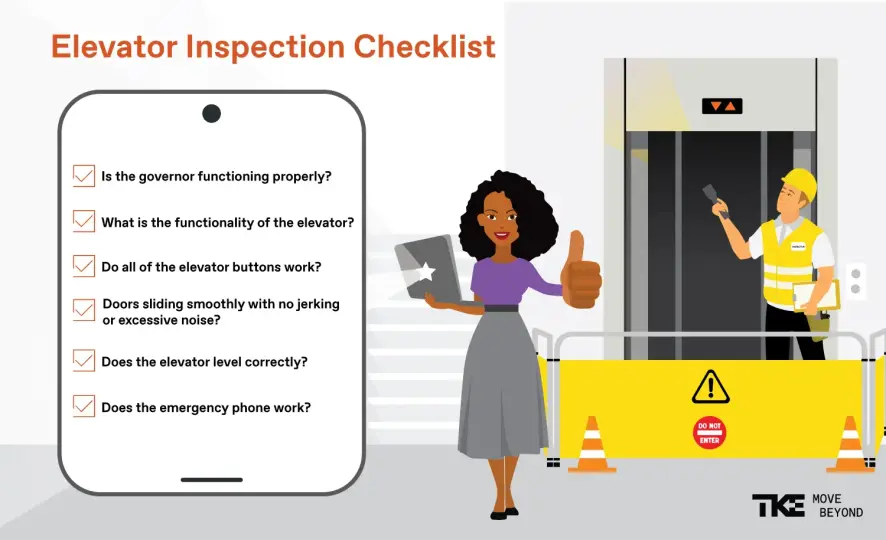What to Expect from Your Elevator Inspection
By Michael Simmons, DBA
There are few phrases that can start a bead of sweat across the brow of many general contractors and building owners. One of which is “colonoscopy,” and the other is “elevator inspection.” For various reasons, I will avoid discussing the former and stick to the latter. As with any piece of complex machinery, an elevator requires constant service and an occasional inspection to verify that it is operating safely. The elevator inspection is a stressor for several reasons: one, if it is the initial inspection of a new elevator, a failure could mean delaying the opening of a building.
If the elevator is currently in service and fails the inspection, this could result in the shutdown of the elevator which is not only inconvenient but could lead to costly repairs. The good news is that with proper planning and proper service, neither one of these nightmare scenarios needs to take place. This article highlights several of the common items examined during an inspection along with tips to ensure that the elevator passes on the first try.
Initial Inspection
Congratulations! You are the proud owner of a baby elevator! But slow down! Before you start smashing those buttons, your equipment needs to pass an initial inspection. Of all the inspections an elevator undertakes, the initial inspection is probably going to be the most involved. During this inspection, not only will the safety and functionality of the elevator be put to the test, but also the overall safety/quality of the shaft (hoistway) and the equipment in the lobby of each landing.

Safety and Functionality of the Elevator
Despite what Hollywood would have you believe, elevators are quite safe due in large part to the numerous safety features installed on every unit. During the initial inspection, the inspector will have the elevator mechanic put the safety features to the test. This includes tripping the governor — a device designed to stop the elevator if it begins to travel too quickly — and testing the door clutch, which keeps the door closed when not safely leveled at the appropriate landing.
Several of these tests are conducted with test weights in the elevator cab ranging from 125% to 150% of its rated maximum capacity. This confirms that all the safety features will function when the car is completely full of passengers. The inspector will also check the functionality of the elevator: do all of the buttons work? Are the doors sliding smoothly with no jerking or excessive noise? Does the elevator level correctly? Does the emergency phone work?
Safety and Functionality of the Hoistway and Lobby
During the initial inspection, an inspector will also carefully check the safety and quality of the hoistway and lobby. The inspector will ride on top of the elevator and confirm that all gaps in the walls have been correctly fire-stopped. They will also make sure that there is sufficient refuge space above and below the elevator for a mechanic. The inspector will also check the functionality of the smoke detectors in the hoistway and lobbies to confirm that they cause the elevator to perform specific functions in case a fire starts in the building. Finally, the inspector will check for proper lighting in the lobbies and machine room, for any trip hazards, and for any obstacles to egress from the elevator to the outside.
Annual and Five-Year Inspections
All elevators require an annual inspection; however, traction elevators (elevators with cables and pullies, think Die Hard) require an additional inspection every five years. During the annual inspection, the inspector will once again test all the safety features of the elevator such as counterweight safeties, governors, oil buffers and car door closing force. During the five-year inspection for traction elevators, the inspector will conduct all the inspections for an annual test but will also put the elevator under a 125% capacity load and check the brakes and safeties to ensure they hold the car in place within a half-inch when triggered. The inspector will also carefully check the elevator cables (ropes) for wear and tear and signs of fraying, rubbing or weakness.
Setting Up for Success
Did you ever have a teacher that gave you all the answers to the test to study? The great part about an elevator inspection is that we already know what the inspector will be looking for — we just need to “study” or prepare for the test. During the installation of a new TK Elevator, the mechanic, superintendent or operations manager will provide the general contractor with a pre-inspection checklist. This list, while not fool-proof, will eliminate the vast majority of items that commonly cause an inspection to fail.
If TK Elevator is servicing the elevator, the service mechanic performs maintenance on the equipment during each visit to ensure that the equipment is functioning properly on inspection day. By following the guide of the pre-inspection checklist and using TK Elevator for service, you have “studied for the test” and are ready for inspection. The bottom line is that with proper planning and maintenance, an elevator inspection does not have to be something to strike fear into your heart.
Learn more about how to maintain your elevator.
 United States
United States

